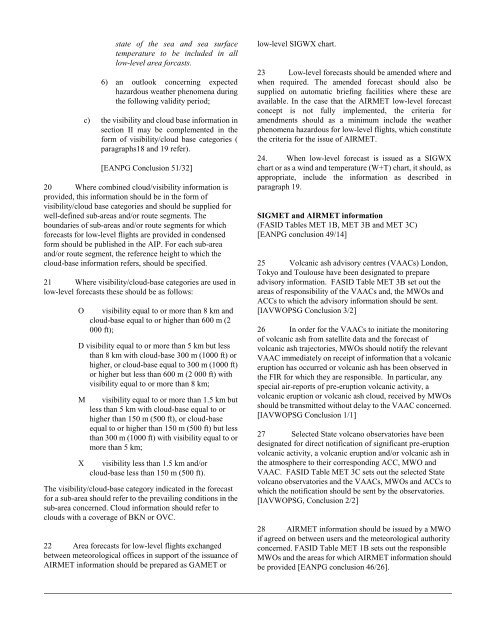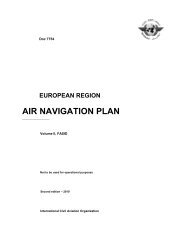7754 Vol 1 Flyleaf - ICAO Public Maps
7754 Vol 1 Flyleaf - ICAO Public Maps
7754 Vol 1 Flyleaf - ICAO Public Maps
You also want an ePaper? Increase the reach of your titles
YUMPU automatically turns print PDFs into web optimized ePapers that Google loves.
state of the sea and sea surface<br />
temperature to be included in all<br />
low-level area forcasts.<br />
6) an outlook concerning expected<br />
hazardous weather phenomena during<br />
the following validity period;<br />
c) the visibility and cloud base information in<br />
section II may be complemented in the<br />
form of visibility/cloud base categories (<br />
paragraphs18 and 19 refer).<br />
[EANPG Conclusion 51/32]<br />
20 Where combined cloud/visibility information is<br />
provided, this information should be in the form of<br />
visibility/cloud base categories and should be supplied for<br />
well-defined sub-areas and/or route segments. The<br />
boundaries of sub-areas and/or route segments for which<br />
forecasts for low-level flights are provided in condensed<br />
form should be published in the AIP. For each sub-area<br />
and/or route segment, the reference height to which the<br />
cloud-base information refers, should be specified.<br />
21 Where visibility/cloud-base categories are used in<br />
low-level forecasts these should be as follows:<br />
O visibility equal to or more than 8 km and<br />
cloud-base equal to or higher than 600 m (2<br />
000 ft);<br />
D visibility equal to or more than 5 km but less<br />
than 8 km with cloud-base 300 m (1000 ft) or<br />
higher, or cloud-base equal to 300 m (1000 ft)<br />
or higher but less than 600 m (2 000 ft) with<br />
visibility equal to or more than 8 km;<br />
M visibility equal to or more than 1.5 km but<br />
less than 5 km with cloud-base equal to or<br />
higher than 150 m (500 ft), or cloud-base<br />
equal to or higher than 150 m (500 ft) but less<br />
than 300 m (1000 ft) with visibility equal to or<br />
more than 5 km;<br />
X visibility less than 1.5 km and/or<br />
cloud-base less than 150 m (500 ft).<br />
The visibility/cloud-base category indicated in the forecast<br />
for a sub-area should refer to the prevailing conditions in the<br />
sub-area concerned. Cloud information should refer to<br />
clouds with a coverage of BKN or OVC.<br />
22 Area forecasts for low-level flights exchanged<br />
between meteorological offices in support of the issuance of<br />
AIRMET information should be prepared as GAMET or<br />
low-level SIGWX chart.<br />
23 Low-level forecasts should be amended where and<br />
when required. The amended forecast should also be<br />
supplied on automatic briefing facilities where these are<br />
available. In the case that the AIRMET low-level forecast<br />
concept is not fully implemented, the criteria for<br />
amendments should as a minimum include the weather<br />
phenomena hazardous for low-level flights, which constitute<br />
the criteria for the issue of AIRMET.<br />
24. When low-level forecast is issued as a SIGWX<br />
chart or as a wind and temperature (W+T) chart, it should, as<br />
appropriate, include the information as described in<br />
paragraph 19.<br />
SIGMET and AIRMET information<br />
(FASID Tables MET 1B, MET 3B and MET 3C)<br />
[EANPG conclusion 49/14]<br />
25 <strong>Vol</strong>canic ash advisory centres (VAACs) London,<br />
Tokyo and Toulouse have been designated to prepare<br />
advisory information. FASID Table MET 3B set out the<br />
areas of responsibility of the VAACs and, the MWOs and<br />
ACCs to which the advisory information should be sent.<br />
[IAVWOPSG Conclusion 3/2]<br />
26 In order for the VAACs to initiate the monitoring<br />
of volcanic ash from satellite data and the forecast of<br />
volcanic ash trajectories, MWOs should notify the relevant<br />
VAAC immediately on receipt of information that a volcanic<br />
eruption has occurred or volcanic ash has been observed in<br />
the FIR for which they are responsible. In particular, any<br />
special air-reports of pre-eruption volcanic activity, a<br />
volcanic eruption or volcanic ash cloud, received by MWOs<br />
should be transmitted without delay to the VAAC concerned.<br />
[IAVWOPSG Conclusion 1/1]<br />
27 Selected State volcano observatories have been<br />
designated for direct notification of significant pre-eruption<br />
volcanic activity, a volcanic eruption and/or volcanic ash in<br />
the atmosphere to their corresponding ACC, MWO and<br />
VAAC. FASID Table MET 3C sets out the selected State<br />
volcano observatories and the VAACs, MWOs and ACCs to<br />
which the notification should be sent by the observatories.<br />
[IAVWOPSG, Conclusion 2/2]<br />
28 AIRMET information should be issued by a MWO<br />
if agreed on between users and the meteorological authority<br />
concerned. FASID Table MET 1B sets out the responsible<br />
MWOs and the areas for which AIRMET information should<br />
be provided [EANPG conclusion 46/26].














